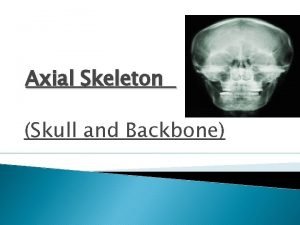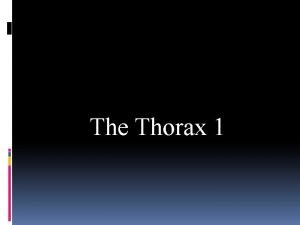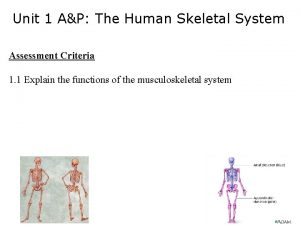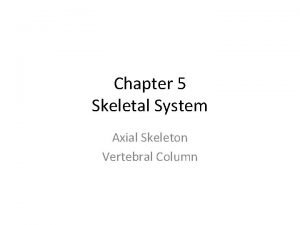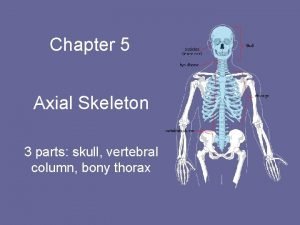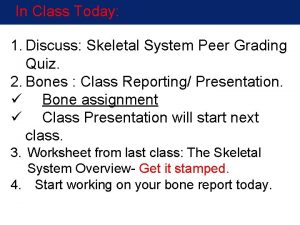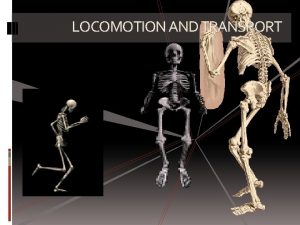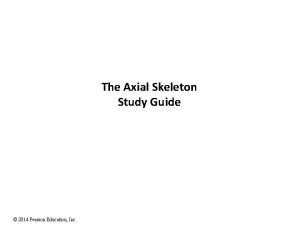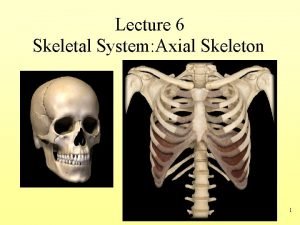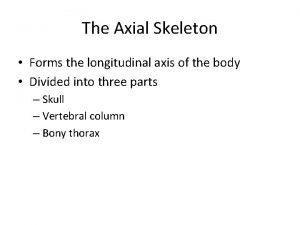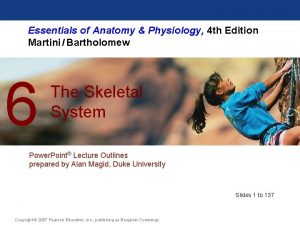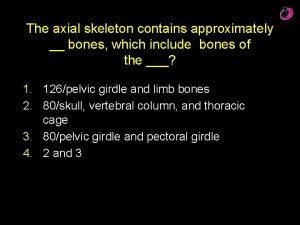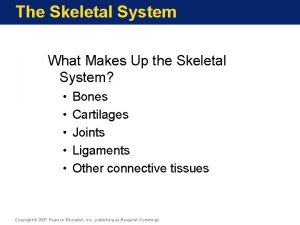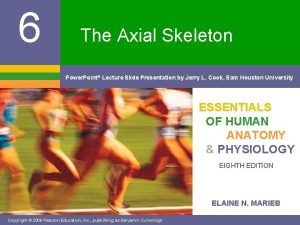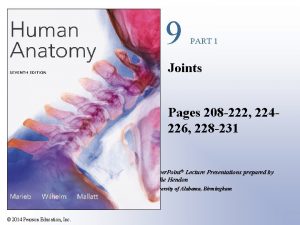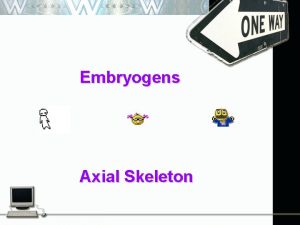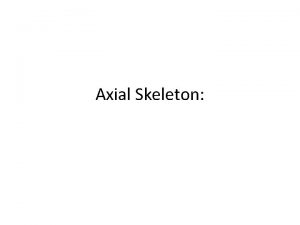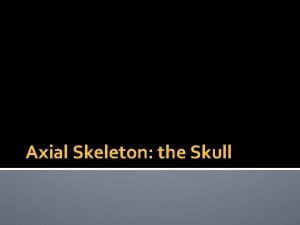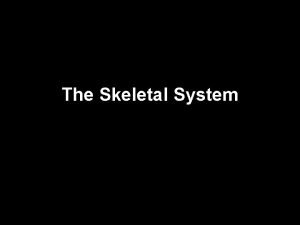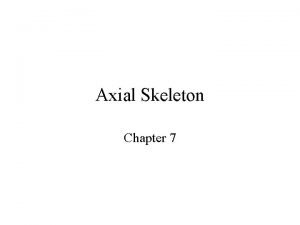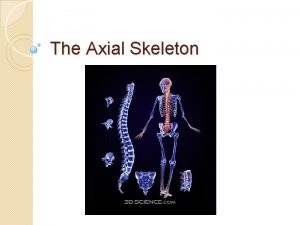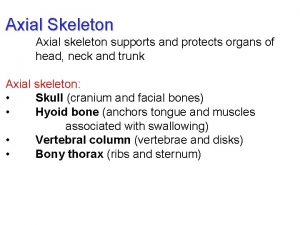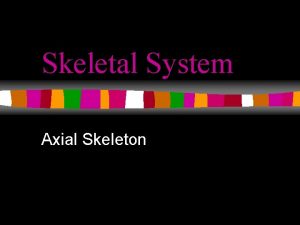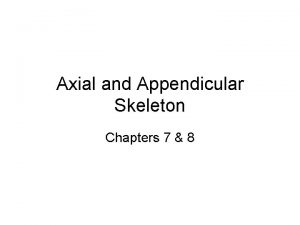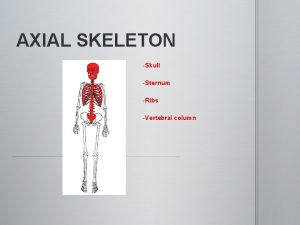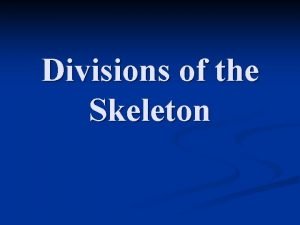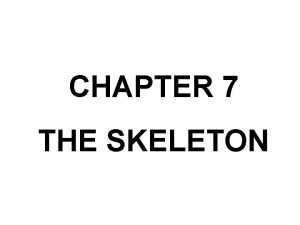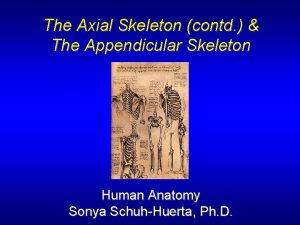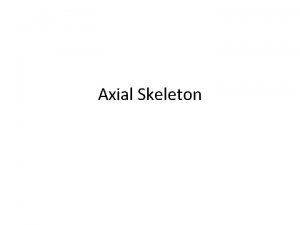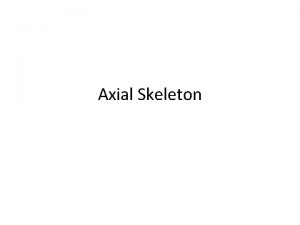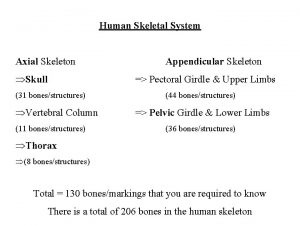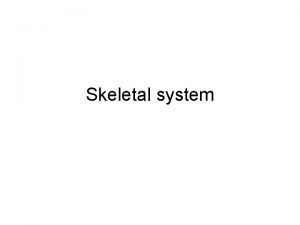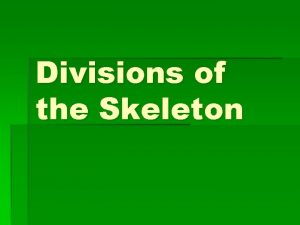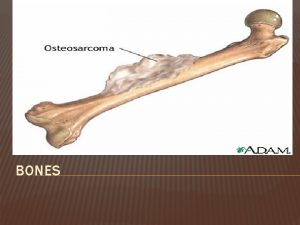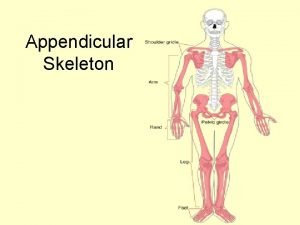Joints of the axial skeleton o Joints of















































- Slides: 47

Joints of the axial skeleton o Joints of the head o Joints of the spine o Joints of the thorax Coto

Joints of the head o Temporomandibular joint o Mandibular symphysis o Joints of the hyoid apparatus o Sutures Coto

Temporomandibular joint o Os temporale – Mandibula o Ginglymus o Discus articularis o Lig. laterale o Lig. caudale (Ru, eq) Coto

Symphysis of Mandible o Right and left half of the mandible are fused on the midsagittal plane. The conjunction is strong in carnivores for biting their prey, however weaker in omnivores. Coto

Joints of the Hyoid Bones o Hyoid apparatus consists of the number of bones that are connected with each other by synovial joints. o Hyoid apparatus is also articulated with the larynx by a synovial joint o Hyoid apparatus is attached to the tympanicum of the temporal bone by a fibrous joint Coto

Sutures of the head o Suture is a type of fibrous joint between the skull bones. Coto

Joints of the spine q Art. atlantooccipitalis q Art. atlantoaxialis q Joints between the vertebral body - Symphysis intervertebralis Discus intervertebralis Anulus fibrosus / Nucleus pulposus o Joints between the vertebral arches - Artt. processus articularium - Artt. intertransversariae lumbales (eq) - Art. intertransversaria lumbosacralis (eq) o Joints between the vertebrae and ribs - Artt. costovertebrales - Art. capitis costae - Art. costotransversaria Coto

Atlantooccipital joint q Atlanto-occipital joint is a condyloid (ellipsoidal) type of a synovial joint. q It is called as «YES» joint. It allows to nod the head and provides on the flexion, extension and slightly lateral motions of the head. q The joint has two joint capsules for each condylus of occipital bone. q The joint has dorsal and ventral membranes which prevent excessive movement of the joint Coto

Atlantoaxial joint q Atlanto-occipital joint is a pivot (throcoid) type of a synovial joint. q It is called as «NO» joint. It provides on the rotational lateral motions of the head. q The joint has a capsule and is supported by several ligaments Coto

Joints of vertebral body q Symphysis intervertebralis is a type of cartiloginous junction between adjacent vertebral bodies allows the slight movement of vertebrae. It is designed for weight bearing and strenght. The articulating surfaces of the adjacent vertebrae are covered with hyaline cartilage and are connected by a fibrocartilaginous intervertebral disc and ligaments. q Intervertebral disc consist of an outer fibrous ring (anulus fibrosus) and an inner gellike center (nucleus pulposus). It separetes the vertebrae, it also holds the vertebrae like a ligament. It functions like a shock-absorber. Coto

Joints of vertebral arches q These joints are found between the cranial and caudal facets of adjoining vertebral arches. They are a gliding type of the synovial joint. The flat surfaces of the articular facets are covered with hyaline cartilage and surrounded by as thin, loose articular capsule Coto

Ligaments of the Spine Short Ligaments of the Spine; o Lig. flava: is a broad, elastic band joins the laminae of adjacent vertebral arches o Lig. interspinalia: is a weak band fills the space between spinous processes o Lig. supraspinale: is a strong cord shaped band joins the top of spinous processes o Lig. intertransversaria: connects the adjacent transverse processes. It is membranous and well-developed in lumbar portion Coto

Ligaments of the Spine Long Ligaments of the Spine; o Lig. longitudinale dorsale : This is a narrower, weaker band runs along the posterior aspect of the vertebral bodies, within the vertebral canal. It lies from the axis to the sacrum. It helps to prevent hyperflexion of the vertebral column and posterior protrusion of the nucleus pulposus of the disc. o Lig. longitudinale ventrale : This is a strong, broad fibrous band that covers and connects the ventral aspects of the bodies of the vertebrae and intervertebral discs. It extends from the atlas to the pelvic surface of the sacrum. This strong ligament helps to maintain the stability of the joints between the vertebral bodies and helps prevent hyperextension of the vertebral column o Lig. nuchae*** Coto

Ligamentum Nuchae - It is a strong elastic band located at the back of neck. - It helps bearing the head so it is welldeveloped in long necked animals. - The nuchal ligament extends from the external occipital protuberance on the skull to the spinous process of the seventh cervical vertebra and is continuous with the supraspinous ligament. o Absent in cat and pig o Weak in dog and man Coto

Ligamentum Nuchae o FUNICULUS NUCHAE - Protuberantia occipitalis ext. (ru, eq) - Axis, dens (ca) o LAMINA NUCHAE (ru, eq) - It is a two layered sheet like band located between the funiculus nuchae and spinous processes of cervical vertebras. - The strong neck muscles attaches to the lamina. *** Supraspinous bursa : is a constant pad located inside the nuchal cord under the skin at the withers Coto

Joints of thorax o Artt. costovertebrales (gliding joint) - Art. capitis costae - Art. costotransversaria o Artt. costochondrales (synchondrosis) o Artt. sternocostales (synchondrosis) o Synchondrosis sternales - Synchondrosis manubriosternalis - Synchondrosis xiphosternalis Coto

ARTICULATIONES MEMBRI THORACICI o Articulatio humeri o Articulatio cubiti o Articulationes manus *Art. carpi *Artt. metacarpophalangeae *Artt. interphalangeae prox. manus *Artt. interphalangeae dist. manus Coto

Articulatio humeri (Shoulder joint) o Scapula - Humerus o Art. simplex o Art. spheroidea o Labrum glenoidale o Lig. coracohumerale o Ligg. glenohumeralia Coto

Articulatio humeri (Shoulder joint) o Scapula - Humerus o Art. simplex o Art. spheroidea o Labrum glenoidale o Lig. coracohumerale o Ligg. glenohumeralia Coto

Articulatio humeri (Shoulder joint) o Scapula - Humerus o Art. simplex o Art. spheroidea o Labrum glenoidale o Lig. coracohumerale o Ligg. glenohumeralia Coto

Articulatio humeri (Shoulder joint) o Scapula - Humerus o Art. simplex o Art. spheroidea o Labrum glenoidale o Lig. coracohumerale o Ligg. glenohumeralia Coto

Articulatio humeri (Shoulder joint) o Scapula - Humerus o Art. simplex o Art. spheroidea o Labrum glenoidale o Lig. coracohumerale o Ligg. glenohumeralia o Hareketler: - Flexion - Extension *abduction - adduction Coto

Articulatio cubiti (Elbow joint) o Humerus – Radius – Ulna o Art. composita (compound joint) *Art. humeroradialis *Art. humeroulnaris *Art. radioulnaris prox. (car) o Ginglymus (hinge joint) o Lig. collaterale cubiti laterale o Lig. collaterale cubiti mediale Coto

Articulatio cubiti (Elbow joint) o Humerus – Radius – Ulna o Art. composita *Art. humeroradialis *Art. humeroulnaris o Ginglymus o Lig. collaterale cubiti laterale o Lig. collaterale cubiti mediale - Flexion - Extension Coto

Articulatio carpi (Carpal joint) o Antebrachium – Carpus – Metacarpus o Art. composita (compound joint) *Art. antebrachiocarpeae *Artt. mediocarpeae *Art. carpometacarpeae *Artt. intercarpeae o Art. plana o Lig. collaterale carpi laterale o Lig. collaterale carpi mediale o Ligg. intercarpea dorsalia o Ligg. intercarpea palmaria Coto

Articulatio carpi (Carpal joint) o Antebrachium – Carpus – Metacarpus o Art. composita *Art. antebrachiocarpeae *Artt. intercarpeae *Art. mediocarpeae *Artt. carpometacarpeae o Art. plana o Lig. collaterale carpi laterale o Lig. collaterale carpi mediale o Ligg. intercarpea dorsalia o Ligg. intercarpea palmaria ***Carpal Tunnel Sendrom*** Coto

Articulatio metacarpophalangea (Fetlock joint) o Metacarpus – Phalanx proximalis – Ossa sesamoidea prox. o Art. composita (compound joint) o Ginglymus (hinge joint) o Ligg. collateralia Coto

Articulationes interphalangeae proximales manus (Pastern joint) o Phalanx proximalis – Phalanx media o Art. simplex o Art. sellaris o Lig. collaterale mediale Coto

Articulationes interphalangeae distales manus (Coffin joint) o Phalanx media – Phalanx distalis o Art. simplex o Art. sellaris o Lig. collaterale mediale ***Bursa podotrochlearis (Bursa navicularis) Coto

Bursa podotrochlearis (Bursa navicularis) Anatomy; Os sesamoideum distale (os naviculare) + tendon of m. flex. dig. prof. Bursa navicularis o + Lig. impar Navicular Syndrome: It most commonly describes an inflammation or degeneration of the navicular bone and its surrounding tissues Coto

ARTICULATIONES MEMBRI PELVINI o Articulatio sacroiliaca o Articulatio coxae o Articulatio genus o Articulatio pedis *Art. tarsi *Artt. metatarsophalangeae *Artt. interphalangeae proximales pedis *Artt. interphalangeae distales pedis Coto

Articulatio sacroiliaca (Sacroiliac joint) o Sacrum – Os ilium o Art. simplex o Art. plana - Amphiarthrosis o Lig. sacrotuberale latum (lig. sacroischiadicum) o Lig. sacrotuberale (ca) o For. ischiadicum majus o For. ischiadicum minus Coto

Articulatio coxae (Hip joint) o Os coxae – Femur o Art. simplex o Art. spheroidea o Labrum acetabulare o Lig. transversum acetabuli o Lig. capitis ossis femoris o Lig. accessorium ossis femoris (Eq. ) Coto

Articulatio coxae (Hip joint) o Os coxae – Femur o Art. simplex o Art. spheroidea o Labrum acetabulare (acetabular rim) o Lig. transversum acetabuli o Lig. capitis ossis femoris (round ligament) o Lig. accessorium ossis femoris (Eq. ) Coto

Articulatio coxae (Hip joint) o Os coxae – Femur o Art. simplex o Art. spheroidea o Labrum acetabulare (acetabular rim) o Lig. transversum acetabuli o Lig. capitis ossis femoris (round ligament) o Lig. accessorium ossis femoris (Eq. ) Coto

Articulatio coxae (Hip joint) o Movement; o Flexion – Extension o Abduction – Adduction Coto

Hip dysplasia o One of the most common skeletal diseases seen in dogs. It is the failure of the hip joints to develop normally (known as malformation) and leading to loss of function. The caput of the femur is not deeply and tightly held by the acetabulum. Instead of being a snug fit, it is a loose or a partial fit. The development of disease is determined by an interaction of genetic (large breeds) and environmental factors (obesity). o X-rays are crucial for visualizing the signs of hip dysplasia o Pain. Reluctance to run, jump, or climb stairs (Bunny-hooping). Intermittent or persistent hind-limb lameness o Teight control, exercise control, medication (reducing pain and inflamation) and surgery (TPO) Coto

Articulatio genus (Stifle joint) o Femur – Patella – Tibia Fibula + Fabellae (car) o Art. composita (compound joint) *Art. femoropatellaris - *Art. femorotibialis Coto

Articulatio femoropatellaris o Femur – Patella o Art. simplex o Art. delabens o Lig. femoropatellare laterale o Lig. femoropatellare mediale o Lig. patellae (su, car, ov, cap) In the horse and ox, the distal tendon of quadriceps is divided into three parts. *Lig. patellae laterale *Lig. patellae intermedium *Lig. patellae mediale ***Patellar luxation*** Coto

Articulatio femoropatellaris o Patellar luxation; - Small breeds predispose to luxation (Yorkshire terrier. . . ) - Deviation occurs in medial side generally. - Surgery Coto

Articulatio femorotibialis o Femur – Tibia o Art. simplex o Art. bicondylaris (Incoungrent ginglymus) o Lig. collaterale mediale o Menuscus lateralis o Menuscus medialis o Lig. cruciatum craniale o Lig. cruciatum caudale Coto

Articulatio femorotibialis o Lig. collaterale mediale o Menuscus lateralis * Lig. meniscofemorale o Menuscus medialis o Lig. cruciatum craniale o Lig. cruciatum caudale Coto

Articulatio femorotibialis o Menisci are C-shaped pieces of cartilage which sit between the medial and lateral chondyles of the femur and the tibial plateau. They provide the adjustment of the joint surface as cushion function. o There are two meniscotibial ligaments for each meniscus and a meniscofemoral lig. for the caudal end of lateral meniscus. Menisci also connect via intermeniscal lig. Coto

Articulatio femorotibialis o Cruciate ligaments: The joint is stabilized by paired cruciate ligaments which act to prevent rotation at the joint. They extend from the tibial plateu to the intercondylar fossa of the femur. Coto

Rupture of Cranial Cruciate Ligment The cranial cruciate resists over-extension and inward rotation, and is the most commonly damaged stifle ligament in dogs. Coto

Articulatio tarsi o Crus – Tarsus – Metatarsus o Art. composita *Art. tarsocruralis *Artt. intertarseae *Artt. tarsometatarseae o Ligg. collateralia Coto

o Articulationes metatarsophalangeae (fetlock joint) o Articulationes interphalangeae proximalis pedis (pastern joint) o Articulationes interphalangeae distales pedis (coffin joint) Coto
 Axial vs appendicular
Axial vs appendicular Axial skeleton vs appendicular
Axial skeleton vs appendicular Axial skeleton vs appendicular skeleton
Axial skeleton vs appendicular skeleton Arms movement
Arms movement Figure 6-4 the skeleton axial and appendicular divisions
Figure 6-4 the skeleton axial and appendicular divisions Sadpam
Sadpam Chapter 5 the skeletal system vertebral column
Chapter 5 the skeletal system vertebral column Receive
Receive Figure 6-4 the skeleton axial and appendicular divisions
Figure 6-4 the skeleton axial and appendicular divisions Concept map: bones of the pelvic girdle
Concept map: bones of the pelvic girdle Pearson
Pearson Axial skeleton
Axial skeleton Chapter 5 the skeletal system figure 5-13
Chapter 5 the skeletal system figure 5-13 Difference between axial and appendicular skeleton
Difference between axial and appendicular skeleton Axial skeleton
Axial skeleton Figure 6-4 the skeleton axial and appendicular divisions
Figure 6-4 the skeleton axial and appendicular divisions The axial skeleton contains
The axial skeleton contains Figure 6-2 structure of a typical bone
Figure 6-2 structure of a typical bone Axial skeleton vertebral column
Axial skeleton vertebral column Chapter 5 the skeletal system figure 5-13
Chapter 5 the skeletal system figure 5-13 Joint cavity
Joint cavity Vẽ hình chiếu đứng bằng cạnh của vật thể
Vẽ hình chiếu đứng bằng cạnh của vật thể Nguyên nhân của sự mỏi cơ sinh 8
Nguyên nhân của sự mỏi cơ sinh 8 Phản ứng thế ankan
Phản ứng thế ankan Voi kéo gỗ như thế nào
Voi kéo gỗ như thế nào Thiếu nhi thế giới liên hoan
Thiếu nhi thế giới liên hoan điện thế nghỉ
điện thế nghỉ Một số thể thơ truyền thống
Một số thể thơ truyền thống Trời xanh đây là của chúng ta thể thơ
Trời xanh đây là của chúng ta thể thơ Thế nào là hệ số cao nhất
Thế nào là hệ số cao nhất Lp html
Lp html Số nguyên là gì
Số nguyên là gì Tia chieu sa te
Tia chieu sa te đặc điểm cơ thể của người tối cổ
đặc điểm cơ thể của người tối cổ Các châu lục và đại dương trên thế giới
Các châu lục và đại dương trên thế giới Glasgow thang điểm
Glasgow thang điểm Sơ đồ cơ thể người
Sơ đồ cơ thể người ưu thế lai là gì
ưu thế lai là gì Tư thế ngồi viết
Tư thế ngồi viết Cái miệng bé xinh thế chỉ nói điều hay thôi
Cái miệng bé xinh thế chỉ nói điều hay thôi Cách giải mật thư tọa độ
Cách giải mật thư tọa độ Bổ thể
Bổ thể Tư thế ngồi viết
Tư thế ngồi viết Thẻ vin
Thẻ vin Ví dụ về giọng cùng tên
Ví dụ về giọng cùng tên Thể thơ truyền thống
Thể thơ truyền thống Các châu lục và đại dương trên thế giới
Các châu lục và đại dương trên thế giới Hát lên người ơi
Hát lên người ơi

